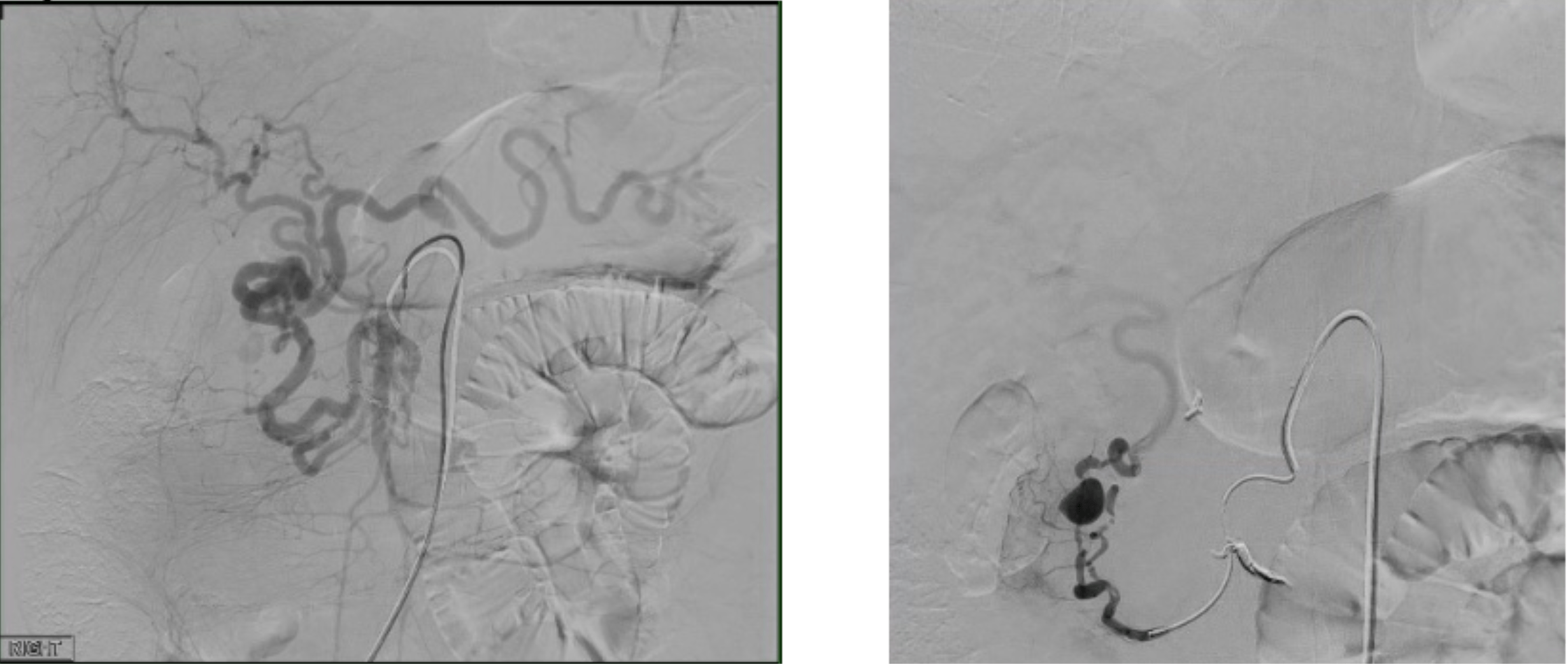Tuesday Poster Session
Category: Biliary/Pancreas
P4501 - Inferior Pancreaticoduodenal Artery Pseudoaneurysm Rupture Presenting as Hemosuccus Pancreaticus
Tuesday, October 28, 2025
10:30 AM - 4:00 PM PDT
Location: Exhibit Hall

Hasham Masood Qureshi, MD (he/him/his)
Adventist Health System
Hanford, CA
Presenting Author(s)
Hasham Masood Qureshi, MD1, Abinaya Rajendaran, MBBS2, Sandhia Masood Qureshi, MBBS3, Dhayanithi Dhayalan, MD1
1Adventist Health System, Hanford, CA; 2Pondicherry institute of Medical Sciences and Research, Hanford, CA; 3Department of Health, Sindh, Pakistan, Hanford, CA
Introduction: Hemosuccus Pancreaticus (HP) is a rare condition, defined as bleeding from the ampulla of vater via the pancreatic duct from a bleeding source in the pancreas and surrounding vasculature. We describe a rare case of inferior pancreaticoduodenal artery pseudoaneurysm secondary to celiac artery stenosis eroding into the CBD and bleeding through the ampulla of vater and santorini presenting as HP.
Case Description/
Methods: A 39-year-old male with a history of multiple episodes of acute alcoholic pancreatitis presented with epigastric abdominal pain, tenderness, nausea, and non-bloody emesis. His previous episode of acute pancreatitis was complicated by a hemorrhagic pancreatic pseudocyst and a common bile duct (CBD) stricture, necessitating stent placement and embolization of a pancreatic arcade artery pseudoaneurysm. Laboratory tests revealed leukocytosis (26.8), elevated liver enzymes, and lipase (2515). Abdominal ultrasound showed CBD dilation (13 mm). Enhanced CT of the abdomen revealed a 3.5 cm mass at the pancreatic head with surrounding inflammatory changes and embolization coils around the pancreas. Acute pancreatitis and acute cholangitis were suspected, prompting an emergent ERCP, which demonstrated fresh red blood in the stomach, duodenum, and large blood clots obstructing the end of the biliary stent and the minor papilla in the duodenum. The biliary stent was retrieved, and a biliary sweep was performed, complicated by active bleeding from the CBD, resulting in hemodynamic instability. Interventional radiology conducted an angiogram that revealed active bleeding from a pseudoaneurysm of the inferior pancreaticoduodenal artery, which was successfully embolized. The patient stabilized and was discharged after three days with outpatient GI follow-up.
Discussion: Hemosuccus pancreaticus is a rare disorder presenting with intermittent gastrointestinal bleeding, hematemesis, abdominal pain, and decreasing hemoglobin. Diagnosis typically involves EGD, CECT, and selective arteriography, though EGD shows active bleeding from the papilla in only 30% of cases. In this instance, the patient exhibited non-bloody emesis and diffuse abdominal pain while being hemodynamically stable. Imaging indicated CBD occlusion with sludge. During EGD and ERCP, blood clots in the papillae were removed, leading to profuse bleeding and hemodynamic instability requiring urgent IR embolization. Management of a pancreaticoduodenal pseudoaneurysm ideally involves elective embolization or surgery.

Figure: Angiogram and embolization

Figure: Endoscopy demonstrating blood and clot
Disclosures:
Hasham Masood Qureshi indicated no relevant financial relationships.
Abinaya Rajendaran indicated no relevant financial relationships.
Sandhia Masood Qureshi indicated no relevant financial relationships.
Dhayanithi Dhayalan indicated no relevant financial relationships.
Hasham Masood Qureshi, MD1, Abinaya Rajendaran, MBBS2, Sandhia Masood Qureshi, MBBS3, Dhayanithi Dhayalan, MD1. P4501 - Inferior Pancreaticoduodenal Artery Pseudoaneurysm Rupture Presenting as Hemosuccus Pancreaticus, ACG 2025 Annual Scientific Meeting Abstracts. Phoenix, AZ: American College of Gastroenterology.
1Adventist Health System, Hanford, CA; 2Pondicherry institute of Medical Sciences and Research, Hanford, CA; 3Department of Health, Sindh, Pakistan, Hanford, CA
Introduction: Hemosuccus Pancreaticus (HP) is a rare condition, defined as bleeding from the ampulla of vater via the pancreatic duct from a bleeding source in the pancreas and surrounding vasculature. We describe a rare case of inferior pancreaticoduodenal artery pseudoaneurysm secondary to celiac artery stenosis eroding into the CBD and bleeding through the ampulla of vater and santorini presenting as HP.
Case Description/
Methods: A 39-year-old male with a history of multiple episodes of acute alcoholic pancreatitis presented with epigastric abdominal pain, tenderness, nausea, and non-bloody emesis. His previous episode of acute pancreatitis was complicated by a hemorrhagic pancreatic pseudocyst and a common bile duct (CBD) stricture, necessitating stent placement and embolization of a pancreatic arcade artery pseudoaneurysm. Laboratory tests revealed leukocytosis (26.8), elevated liver enzymes, and lipase (2515). Abdominal ultrasound showed CBD dilation (13 mm). Enhanced CT of the abdomen revealed a 3.5 cm mass at the pancreatic head with surrounding inflammatory changes and embolization coils around the pancreas. Acute pancreatitis and acute cholangitis were suspected, prompting an emergent ERCP, which demonstrated fresh red blood in the stomach, duodenum, and large blood clots obstructing the end of the biliary stent and the minor papilla in the duodenum. The biliary stent was retrieved, and a biliary sweep was performed, complicated by active bleeding from the CBD, resulting in hemodynamic instability. Interventional radiology conducted an angiogram that revealed active bleeding from a pseudoaneurysm of the inferior pancreaticoduodenal artery, which was successfully embolized. The patient stabilized and was discharged after three days with outpatient GI follow-up.
Discussion: Hemosuccus pancreaticus is a rare disorder presenting with intermittent gastrointestinal bleeding, hematemesis, abdominal pain, and decreasing hemoglobin. Diagnosis typically involves EGD, CECT, and selective arteriography, though EGD shows active bleeding from the papilla in only 30% of cases. In this instance, the patient exhibited non-bloody emesis and diffuse abdominal pain while being hemodynamically stable. Imaging indicated CBD occlusion with sludge. During EGD and ERCP, blood clots in the papillae were removed, leading to profuse bleeding and hemodynamic instability requiring urgent IR embolization. Management of a pancreaticoduodenal pseudoaneurysm ideally involves elective embolization or surgery.

Figure: Angiogram and embolization

Figure: Endoscopy demonstrating blood and clot
Disclosures:
Hasham Masood Qureshi indicated no relevant financial relationships.
Abinaya Rajendaran indicated no relevant financial relationships.
Sandhia Masood Qureshi indicated no relevant financial relationships.
Dhayanithi Dhayalan indicated no relevant financial relationships.
Hasham Masood Qureshi, MD1, Abinaya Rajendaran, MBBS2, Sandhia Masood Qureshi, MBBS3, Dhayanithi Dhayalan, MD1. P4501 - Inferior Pancreaticoduodenal Artery Pseudoaneurysm Rupture Presenting as Hemosuccus Pancreaticus, ACG 2025 Annual Scientific Meeting Abstracts. Phoenix, AZ: American College of Gastroenterology.
